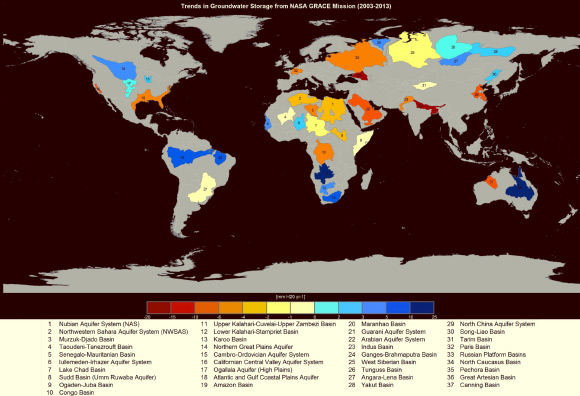Two new studies using data from NASA’s GRACE satellites have found that 21 of planet’s 37 largest aquifers are being rapidly depleted by human consumption, despite having little accurate data about how much water remains in them.

Groundwater storage trends for world’s 37 largest aquifer systems. Of these, 21 have exceeded sustainability tipping points and are being depleted, with 13 considered significantly distressed, threatening regional water security and resilience. Image credit: University of California, Irvine / NASA / JPL-Caltech.
Groundwater aquifers are typically located in soil or deeper rock layers beneath the planet’s surface. The depth and thickness of many make it tough and costly to drill to or otherwise reach bedrock and learn where the moisture bottoms out.
The new studies, published online in the journal Water Resources Research, are the first to characterize groundwater losses via data from space.
In the first of the studies, the authors examined Earth’s 37 largest aquifers between 2003 and 2013. The eight worst off were classified as overstressed, with nearly no natural replenishment to offset usage. Another five aquifers were found, in descending order, to be extremely or highly stressed, depending upon the level of replenishment in each – still in trouble but with some water flowing back into them.
The most overburdened are in the world’s driest areas, which draw heavily on underground water. Climate change and population growth are expected to intensify the problem.
The scientists found that the Arabian Aquifer System, an important water source for more than 60 million people, is the most overstressed in the world.
The Indus Basin aquifer of northwestern India and Pakistan is the second-most overstressed, and the Murzuk-Djado Basin in northern Africa is third.
California’s Central Valley, utilized heavily for agriculture and suffering rapid depletion, was slightly better off but still labeled highly stressed in the first study.
In the second study, the team concluded that the total remaining volume of the world’s usable groundwater is poorly known, with often widely varying estimates, but is likely far less than rudimentary estimates made years ago.
By comparing their satellite-derived groundwater loss rates to what little data exists on groundwater availability, they found major discrepancies in projected ‘time to depletion.’
In the overstressed Northwest Sahara Aquifer System, for example, this fluctuated between 10 and 21,000 years.
“We don’t actually know how much is stored in each of these aquifers. Estimates of remaining storage might vary from decades to millennia,” Richey said.
“In a water-scarce society, we can no longer tolerate this level of uncertainty, especially since groundwater is disappearing so rapidly.”
_____
Alexandra S. Richey et al. Quantifying renewable groundwater stress with GRACE. Water Resources Research, published online June 16, 2015; doi: 10.1002/2015WR017349
Alexandra S. Richey et al. Uncertainty in global groundwater storage estimates in a total groundwater stress framework. Water Resources Research, published online June 16, 2015; doi: 10.1002/2015WR017351







